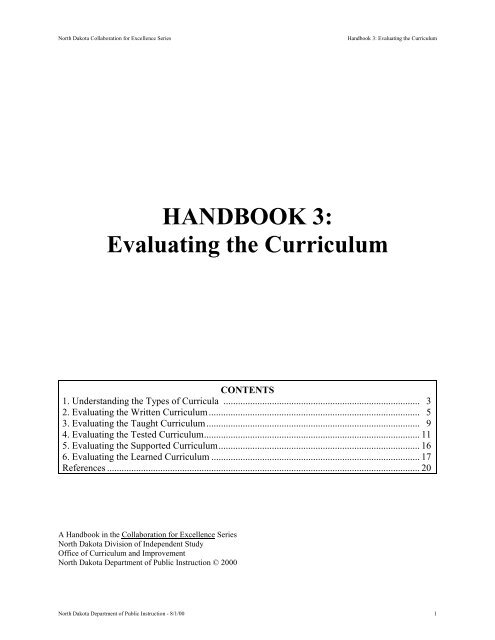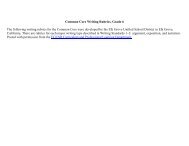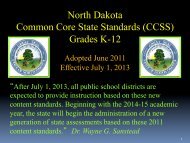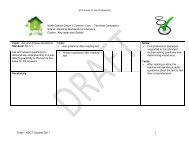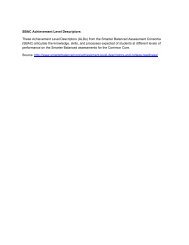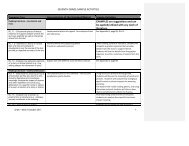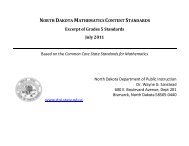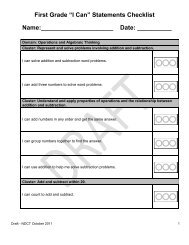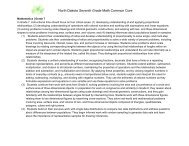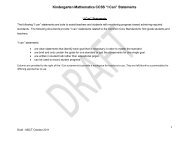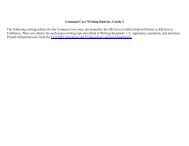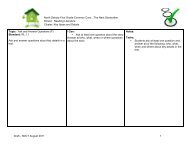Sample Scope and Sequence Chart - ND Curriculum Initiative
Sample Scope and Sequence Chart - ND Curriculum Initiative
Sample Scope and Sequence Chart - ND Curriculum Initiative
Create successful ePaper yourself
Turn your PDF publications into a flip-book with our unique Google optimized e-Paper software.
North Dakota Collaboration for Excellence Series<br />
H<strong>and</strong>book 3: Evaluating the <strong>Curriculum</strong><br />
HA<strong>ND</strong>BOOK 3:<br />
Evaluating the <strong>Curriculum</strong><br />
CONTENTS<br />
1. Underst<strong>and</strong>ing the Types of Curricula ................................................................................. 3<br />
2. Evaluating the Written <strong>Curriculum</strong>....................................................................................... 5<br />
3. Evaluating the Taught <strong>Curriculum</strong>........................................................................................ 9<br />
4. Evaluating the Tested <strong>Curriculum</strong>......................................................................................... 11<br />
5. Evaluating the Supported <strong>Curriculum</strong>................................................................................... 16<br />
6. Evaluating the Learned <strong>Curriculum</strong> ...................................................................................... 17<br />
References ................................................................................................................................. 20<br />
A H<strong>and</strong>book in the Collaboration for Excellence Series<br />
North Dakota Division of Independent Study<br />
Office of <strong>Curriculum</strong> <strong>and</strong> Improvement<br />
North Dakota Department of Public Instruction © 2000<br />
North Dakota Department of Public Instruction - 8/1/00 1
North Dakota Collaboration for Excellence Series<br />
H<strong>and</strong>book 3: Evaluating the <strong>Curriculum</strong><br />
This h<strong>and</strong>book is one of a series published for the project Collaboration for Excellence:<br />
The North Dakota <strong>Curriculum</strong> Project.<br />
The publication is free to public school educators in North Dakota, who may make copies<br />
without permission.<br />
These h<strong>and</strong>books represent a team product. A major contributor was Ann Clapper, who<br />
was previously Director of the Office of <strong>Curriculum</strong> Leadership <strong>and</strong> Improvement. Numerous<br />
educators in North Dakota reviewed all these materials <strong>and</strong> made valuable suggestions.<br />
Especially helpful were the following North Dakota educators: Janet Edlund, Dakota Prairie<br />
High School; Cheryl Kuhas, North Dakota Department of Public Instruction; Karen Nelson,<br />
Hettinger; S<strong>and</strong>ra Willprecht, Forman. Allan A. Glatthorn, Distinguished Research Professor at<br />
East Carolina University, served as consultant to the project.<br />
It should be emphasized that the processes suggested here should be seen only as<br />
recommendations, not m<strong>and</strong>ates. The authors value the ability of North Dakota educators to<br />
develop their own processes that reflect the needs <strong>and</strong> resources of their schools.<br />
North Dakota Department of Public Instruction - 8/1/00 2
North Dakota Collaboration for Excellence Series<br />
H<strong>and</strong>book 3: Evaluating the <strong>Curriculum</strong><br />
1. U<strong>ND</strong>ERSTA<strong>ND</strong>ING THE TYPES OF CURRICULA<br />
<strong>Curriculum</strong> evaluation is a central component of a comprehensive curriculum project.<br />
However, it is not a single process; instead, as explained below, the process varies with the type<br />
of curriculum.<br />
Reviewing the Types of Curricula<br />
Nine types of curricula can be identified:<br />
! Hidden—what students learn from the school’s values <strong>and</strong> policies<br />
! Excluded—the curriculum content that has been omitted<br />
! Recommended—the content recommended by experts<br />
! Written—the curriculum as it appears in state <strong>and</strong> school system documents<br />
! Taught—what teachers actually teach<br />
! Learned—what students learn<br />
! Supported—the curriculum as it appears in texts <strong>and</strong> software<br />
! Tested—the curriculum as it appears in tests <strong>and</strong> other performance measures<br />
! Managed—the curriculum as it is administered (identified through a district audit)<br />
This h<strong>and</strong>book focuses on the evaluation of five of these types: the written, taught,<br />
supported, tested, <strong>and</strong> learned. H<strong>and</strong>book 4 explains how to evaluate the managed curriculum<br />
with a curriculum audit.<br />
Planning for a Comprehensive Evaluation<br />
The Subject Area Committee (SAC) should propose a curriculum evaluation design to the<br />
<strong>Curriculum</strong> Planning Council for their review. A sample of one design is shown in Display 3-1.<br />
Part of the design has been completed, as an example of what should be included.<br />
The information in Display 3-1 should not be construed to mean that all five of these<br />
curricula types must be completed with every curriculum project. The comprehensiveness of the<br />
design will depend on the resources available <strong>and</strong> the needs of the school system. If it is decided<br />
to omit one or more of the evaluations, the task force <strong>and</strong> the council should determine the<br />
district’s priority needs. In general, most school systems will find that the top priority should be<br />
given to the learned, the taught, <strong>and</strong> the written.<br />
North Dakota Department of Public Instruction - 8/1/00 3
North Dakota Collaboration for Excellence Series<br />
H<strong>and</strong>book 3: Evaluating the <strong>Curriculum</strong><br />
Display 3-1:<br />
SAMPLE CURRICULUM EVALUATION PROPOSAL<br />
SUBJECT: Mathematics<br />
CURRICULUM<br />
TYPE WHEN BY WHOM HOW<br />
Written<br />
3/01--11/01 External consultant<br />
Task force<br />
Teachers<br />
Document analysis<br />
Document analysis<br />
Pilot test<br />
Taught<br />
Supported<br />
Tested<br />
Learned<br />
This form should be completed by the Subject Area Committee <strong>and</strong> submitted to the <strong>Curriculum</strong><br />
Planning Council for their review.<br />
North Dakota Department of Public Instruction - 8/1/00 4
North Dakota Collaboration for Excellence Series<br />
H<strong>and</strong>book 3: Evaluating the <strong>Curriculum</strong><br />
2. EVALUATING THE WRITTEN CURRICULUM<br />
The written curriculum includes the documents prepared by the Department of Public<br />
Instruction, the school system, the school, <strong>and</strong> the classroom teacher. For purposes of achieving<br />
depth, this chapter recommends a process for evaluating the written curriculum documents<br />
produced by the school district.<br />
To evaluate the written curriculum, the task force should evaluate the <strong>Scope</strong> <strong>and</strong> <strong>Sequence</strong><br />
<strong>Chart</strong> <strong>and</strong> the <strong>Curriculum</strong> Guide.<br />
Evaluating the <strong>Scope</strong> <strong>and</strong> <strong>Sequence</strong> <strong>Chart</strong><br />
The <strong>Scope</strong> <strong>and</strong> <strong>Sequence</strong> <strong>Chart</strong> is a planning chart for one subject, grades K-12 (see Display<br />
3-2). As explained more fully in H<strong>and</strong>book 8, the <strong>Scope</strong> <strong>and</strong> <strong>Sequence</strong> <strong>Chart</strong> will be used to<br />
develop the more specific <strong>Curriculum</strong> Guide. To evaluate the <strong>Scope</strong> <strong>and</strong> <strong>Sequence</strong> <strong>Chart</strong>, the<br />
task force should:<br />
(1) Complete the survey form in Display 3-3. When discussing <strong>and</strong> completing the survey,<br />
task force members should bring a critical perspective <strong>and</strong> take the time to answer all the<br />
questions.<br />
(2) Arrange for classroom teachers <strong>and</strong> an external consultant to complete the same survey.<br />
Display 3-4 gives one process that may be followed when having teachers evaluate the<br />
chart.<br />
(3) Revise the <strong>Scope</strong> <strong>and</strong> <strong>Sequence</strong> <strong>Chart</strong> based on the evaluations by the task force,<br />
teachers, <strong>and</strong> external consultants.<br />
Display 3-2:<br />
<strong>Sample</strong> <strong>Scope</strong> <strong>and</strong> <strong>Sequence</strong> <strong>Chart</strong><br />
Down the left side of the chart are the curriculum st<strong>and</strong>ards. Across the top are the several grade levels. In<br />
each cell, the benchmarks for that st<strong>and</strong>ard <strong>and</strong> that grade are noted.<br />
Subject: Mathematics<br />
St<strong>and</strong>ard<br />
Grade Level<br />
K 1 2 3 4 5 6 7 8 9 10 11 12<br />
1<br />
2 [Benchmarks are noted in the cells]<br />
3<br />
North Dakota Department of Public Instruction - 8/1/00 5
North Dakota Collaboration for Excellence Series<br />
H<strong>and</strong>book 3: Evaluating the <strong>Curriculum</strong><br />
Display 3-3:<br />
<strong>Scope</strong> <strong>and</strong> <strong>Sequence</strong> <strong>Chart</strong> Evaluation Survey<br />
Please assist us in developing a high quality scope <strong>and</strong> sequence for mathematics by<br />
reviewing the <strong>Scope</strong> <strong>and</strong> <strong>Sequence</strong> <strong>Chart</strong> <strong>and</strong> then completing this survey. To answer each<br />
question, circle one of the following grades:<br />
A: Fully meets this st<strong>and</strong>ard<br />
B: Almost fully meets this st<strong>and</strong>ard<br />
C: Partially meets this st<strong>and</strong>ard<br />
D. Barely meets this st<strong>and</strong>ard<br />
F: Does not at all meet this st<strong>and</strong>ard<br />
: Do not know if it meets this st<strong>and</strong>ard<br />
Does the <strong>Scope</strong> <strong>and</strong> <strong>Sequence</strong> <strong>Chart</strong> for<br />
Mathematics . . .<br />
Rating<br />
1. Seem clear, uncluttered, <strong>and</strong> easy to use A B C D F <br />
2. Provide for curriculum depth A B C D F <br />
3. Note only the mastery benchmarks, those<br />
outcomes that are likely to be tested <strong>and</strong> require<br />
special emphasis at a given grade level A B C D F <br />
4. Indicate a balance in content load among the<br />
several grades, given the maturity of the students<br />
at a particular grade A B C D F <br />
5. Indicate an adequate concern for reinforcement of<br />
skills <strong>and</strong> knowledge, without excessive<br />
repetition A B C D F <br />
6. Indicate effective coordination from grade to<br />
grade A B C D F <br />
7. Specify benchmarks for a given grade level that<br />
are developmentally appropriate A B C D F <br />
8. Indicate st<strong>and</strong>ards <strong>and</strong> benchmarks that correspond<br />
to those recommended by the Department of<br />
Public Instruction A B C D F <br />
9. Place benchmarks in a manner congruent with high<br />
stakes tests A B C D F <br />
10. Sufficiently reflect the recommendations of<br />
scholars in the field A B C D F <br />
North Dakota Department of Public Instruction - 8/1/00 6
North Dakota Collaboration for Excellence Series<br />
H<strong>and</strong>book 3: Evaluating the <strong>Curriculum</strong><br />
Display 3-4:<br />
Procedure for Teacher Evaluation of <strong>Scope</strong> <strong>and</strong> <strong>Sequence</strong> <strong>Chart</strong><br />
1. The task force identifies representative teachers of that subject from all grade levels. A group of 15-<br />
25 would be desirable.<br />
2. The chairperson of the task force explains the key elements of the <strong>Scope</strong> <strong>and</strong> <strong>Sequence</strong> <strong>Chart</strong>, giving<br />
copies to all those present. The chair also explains the items in the Evaluation Survey. The<br />
participants have an opportunity to ask questions of clarification.<br />
3. After appropriate study, the participants complete the survey.<br />
4. Two members of the task force quickly tally the results. The mean score for each item can be easily<br />
determined by assigning the following points to each response: A=5, B= 4, C= 3, D= 2, F=1 <strong>and</strong><br />
dividing the sum by the number surveyed. Do not count the “” responses.<br />
5. The chair leads the group in an analysis of the survey results, inviting the participants to explain more<br />
fully what seem to be weaknesses of the chart.<br />
Evaluating the <strong>Curriculum</strong> Guide<br />
In the process recommended here, the <strong>Curriculum</strong> Guide is based on the <strong>Scope</strong> <strong>and</strong><br />
<strong>Sequence</strong> <strong>Chart</strong>. For this reason such critical issues as grade placement <strong>and</strong> grade-to-grade<br />
coordination would have been dealt with in the evaluation of the <strong>Scope</strong> <strong>and</strong> <strong>Sequence</strong> <strong>Chart</strong>. If<br />
they have not, then they should be assessed in the review of the guide. The special criteria to be<br />
used in assessing the guide are:<br />
! Is the guide easy for teachers to use<br />
! Is the guide formatted for flexible delivery<br />
! Does the guide include only those elements that teachers need<br />
! Is the guide clearly <strong>and</strong> effectively written<br />
! Does the guide have a professional appearance<br />
Two issues relative to the <strong>Curriculum</strong> guide need special analysis: content <strong>and</strong> format.<br />
Content<br />
What should the district guide include This is a matter for local determination. The guide<br />
may include several elements:<br />
! A copy of the <strong>Scope</strong> <strong>and</strong> <strong>Sequence</strong> <strong>Chart</strong><br />
! The mastery benchmarks <strong>and</strong> their associated classroom learning outcomes. Remember<br />
that the classroom learning outcomes are the more specific delineations of the<br />
benchmarks.<br />
! The curriculum philosophy<br />
North Dakota Department of Public Instruction - 8/1/00 7
North Dakota Collaboration for Excellence Series<br />
H<strong>and</strong>book 3: Evaluating the <strong>Curriculum</strong><br />
! The curriculum vision<br />
! The texts <strong>and</strong> other materials<br />
! Suggestions for student assessment<br />
! <strong>Sample</strong> units of study<br />
! The district’s educational goals<br />
! A synthesis of research <strong>and</strong> best practice for teaching that subject<br />
Many guides also include for each outcome a recommended teaching strategy. This practice<br />
seems unwise. It suggests that there is one best teaching strategy for each outcome. And it<br />
implies that teachers’ skills can be developed simply by listing them in a guide.<br />
In determining which elements to include, developers should assess teachers’ needs <strong>and</strong><br />
preferences, keeping in mind the importance of a “teacher-friendly” guide.<br />
Format<br />
The flexible delivery criterion also needs special comment. Instead of packaging the guide<br />
in the st<strong>and</strong>ard form of a large loose-leaf notebook containing the curricula for all the grades, the<br />
council should find out from teachers which format they prefer. Some options:<br />
! Electronic version<br />
! Grade-level version<br />
" Delivered to elementary teachers as a grade level curriculum; thus, a fifth grade<br />
teacher would receive fifth grade language arts, science, mathematics, <strong>and</strong> social<br />
studies.<br />
! Secondary-level version<br />
" Packaged for secondary teachers so that they receive the curriculum for three grades<br />
<strong>and</strong> one subject; thus, a seventh grade science teacher would receive the science<br />
curriculum for Grades 6, 7, <strong>and</strong> 8.<br />
Review<br />
The evaluation of the newly developed <strong>Curriculum</strong> Guide should be performed by the task<br />
force <strong>and</strong> then by a representative group of teachers, who would review it before it is published.<br />
If funds are available, an external consultant might also be asked to evaluate both the guide <strong>and</strong><br />
the <strong>Scope</strong> <strong>and</strong> <strong>Sequence</strong> <strong>Chart</strong>, since they are so closely related. When the new curriculum is<br />
being piloted, it should also be assessed by those piloting the program.<br />
North Dakota Department of Public Instruction - 8/1/00 8
North Dakota Collaboration for Excellence Series<br />
H<strong>and</strong>book 3: Evaluating the <strong>Curriculum</strong><br />
3. EVALUATING THE TAUGHT CURRICULUM<br />
As explained previously, the taught curriculum is the one that the teacher actually teaches;<br />
some experts call it the enacted curriculum. Regardless of the term, it requires a very special<br />
kind of evaluation.<br />
Evaluating the Taught <strong>Curriculum</strong> as Planned<br />
The first step is to assess the taught curriculum in the planning process. As explained in<br />
H<strong>and</strong>book 9, it is recommended that principals provide time for teachers to work together in<br />
making plans for the term or the school year. Once developed, these plans should be reviewed<br />
both by team leaders <strong>and</strong> the principal to be sure that the long-term plans provide for in-depth<br />
underst<strong>and</strong>ing of the mastery benchmarks for that grade. The criteria for evaluating these plans<br />
are in Display 3-5.<br />
Display 3-5:<br />
Criteria for Evaluating the Taught <strong>Curriculum</strong> as Planned<br />
Does the taught curriculum as planned . . .<br />
1. Reflect <strong>and</strong> correspond with the school calendar<br />
2. Note significant events likely to influence teaching <strong>and</strong> learning<br />
3. Organize the benchmarks into units, with titles clearly stated<br />
4. <strong>Sequence</strong> the units appropriately<br />
5. Allocate time appropriately<br />
6. Ensure that all benchmarks are included<br />
7. Reflect the importance of depth of underst<strong>and</strong>ing<br />
North Dakota Department of Public Instruction - 8/1/00 9
North Dakota Collaboration for Excellence Series<br />
H<strong>and</strong>book 3: Evaluating the <strong>Curriculum</strong><br />
Evaluating the Taught <strong>Curriculum</strong> in Progress<br />
A two-step process is recommended for evaluating the taught curriculum in progress.<br />
(1) Informal Evaluation<br />
-- In this type of evaluation, the principal makes brief informal drop-in visits, lasting no<br />
more than ten minutes. One significant advantage of these informal observations is<br />
that they enable the principal to monitor implementation of the curriculum. In such<br />
visits the principal should note what is being taught. If the principal then determines<br />
that the topic taught was not included in the <strong>Curriculum</strong> Guide, then the principal<br />
should confer briefly with the teacher to underst<strong>and</strong> the reason for the divergence<br />
from the approved curriculum. Note that diverging from the approved curriculum to<br />
teach enrichment units is recommended.<br />
(2) Formal Evaluation<br />
-- If the principal believes that a teacher is frequently diverging from the planned<br />
curriculum due to poor planning, then a team leader or supervisor should be asked to<br />
make a more formal observation that focuses on the taught curriculum. A suggested<br />
set of criteria is in Display 3-6. The observation should be followed by a conference,<br />
in which the observer should help the teacher solve the problem of too much<br />
divergence.<br />
Display 3-6:<br />
Criteria for Evaluating the Taught <strong>Curriculum</strong> in Progress<br />
1. Is the content of the lesson related to the approved curriculum<br />
2. Does the lesson aim to develop in-depth underst<strong>and</strong>ing<br />
3. Does the teacher demonstrate in-depth knowledge of the content<br />
4. Does the teacher make the content meaningful to the students<br />
5. Does the teacher adapt the approved curriculum to the special needs of the students<br />
North Dakota Department of Public Instruction - 8/1/00 10
North Dakota Collaboration for Excellence Series<br />
H<strong>and</strong>book 3: Evaluating the <strong>Curriculum</strong><br />
4. EVALUATING THE TESTED CURRICULUM<br />
The tested curriculum usually includes four kinds of tests of student learning:<br />
! st<strong>and</strong>ardized, norm-referenced tests,<br />
! state tests,<br />
! district tests, <strong>and</strong><br />
! classroom tests.<br />
The focus of this chapter is on classroom tests, since they play such a major role in student<br />
achievement <strong>and</strong> are relatively simple to improve.<br />
Helping Teachers Develop <strong>and</strong> Evaluate Classroom Tests<br />
Teachers will need the assistance of the principal in developing <strong>and</strong> evaluating classroom<br />
tests. If the principal can help teachers develop more valid classroom tests, then both can rely<br />
upon test results with greater confidence. Developing valid <strong>and</strong> reliable classroom tests is an<br />
important <strong>and</strong> complex skill. To develop better tests, teachers <strong>and</strong> principals should follow these<br />
steps.<br />
(1) Assess the constraints <strong>and</strong> resources.<br />
-- This first step examines some practical considerations—what constraints will place<br />
limits on the nature of the test <strong>and</strong> what resources are available to help the teacher<br />
develop the test<br />
(2) Analyze what was taught.<br />
-- There are several useful ways of analyzing what was taught. One useful method is<br />
illustrated in Display 3-7. This method uses categories of objectives that correspond<br />
with the way teachers typically conceptualize units: terms; facts <strong>and</strong> information; big<br />
ideas; skills <strong>and</strong> processes; critical thinking <strong>and</strong> problem solving.<br />
(3) Determine which objectives will be tested.<br />
-- Most teachers do not want to take the classroom time needed to test everything that<br />
was taught. The teacher should select from the complete list of taught material those<br />
items that they believe should be tested, considering such elements as the importance<br />
of that item for future work, the amount of time devoted to teaching it, the resources<br />
available, <strong>and</strong> the time required for testing it.<br />
(4) Determine relative weights for all objectives to be tested.<br />
-- The weights serve three purposes: they help the teacher prepare the test; they help the<br />
students allocate time during the test; <strong>and</strong> they aid the teacher in scoring the test.<br />
The easiest way to indicate relative weights is with a percentage figure.<br />
North Dakota Department of Public Instruction - 8/1/00 11
North Dakota Collaboration for Excellence Series<br />
H<strong>and</strong>book 3: Evaluating the <strong>Curriculum</strong><br />
Display 3-7:<br />
Unit Analysis Form Example<br />
1. List the terms taught.<br />
! natural resource, renewable resource, pollution, environment, conservation, water treatment plant, sewage<br />
treatment plant, phosphate, algae, solar energy<br />
2. List the facts <strong>and</strong> information taught.<br />
! Environmental Protection Agency is a government agency that monitors compliance with laws<br />
! Taking a shower uses 95 liters of water; taking a bath uses 133 liters<br />
! The manufacture of plastics requires the use of strong chemicals <strong>and</strong> high temperatures<br />
! Between 1980 <strong>and</strong> 1985 the world population increased by about 550 million people<br />
3. List the big ideas taught.<br />
! The water cycle<br />
! Acid rain<br />
4. List the skills <strong>and</strong> processes taught.<br />
! Interpret a table of data<br />
! Identify common causes of air pollution<br />
5. List the critical thinking <strong>and</strong> problem-solving skills taught.<br />
! Analyze the trade-off involved in requiring factories to reduce pollution--cleaner air results in higher prices<br />
for the consumer<br />
! Explain how one person can make a difference in conservation<br />
The unit analysis form can be distributed to students to help them prepare for the test; it can also be used by the<br />
teacher as a means of guiding the review work.<br />
(5) Write the test items.<br />
-- The information collected thus far is now used to write test items. The teacher first<br />
determines the type of questions to be used for each objective, weighing both issues<br />
of validity (which type will most validly assess learning) <strong>and</strong> utility (which type<br />
will be easiest to score). Display 3-8 lists the advantages <strong>and</strong> disadvantages of the<br />
various item types.<br />
North Dakota Department of Public Instruction - 8/1/00 12
North Dakota Collaboration for Excellence Series<br />
H<strong>and</strong>book 3: Evaluating the <strong>Curriculum</strong><br />
Display 3-8:<br />
Item Types<br />
Item Type Advantage Disadvantage<br />
Essay Measure the ability to reason Difficult to score<br />
Fill-in-the-blank Best for sampling knowledge More time-consuming than<br />
other short-answer types (both<br />
for student <strong>and</strong> teacher)<br />
True-false Easy to score Permit guessing; do not<br />
validly assess objectives that<br />
cannot be so dichotomized<br />
Matching Easy to score Permit guessing<br />
Multiple choice Easy to score Permit guessing<br />
Performance/demonstration<br />
Yield valid information about<br />
learning<br />
Difficult to construct <strong>and</strong><br />
score<br />
(6) Assemble the test.<br />
-- In assembling the test, the teacher has several choices about how questions should be<br />
ordered <strong>and</strong> grouped.<br />
* By content; for example, all the questions dealing with the battles of the Civil<br />
War could be grouped together.<br />
* By behavior desired, such as grouping all the knowledge-comprehension items<br />
together.<br />
* By difficulty, beginning with the easier questions, especially recommended when<br />
the items are relatively homogeneous with respect to content <strong>and</strong> behavior.<br />
* By item type; recommended when different kinds of items are used (such as truefalse,<br />
multiple choice); this makes it easier for the teacher to give directions <strong>and</strong><br />
the student to follow them.<br />
(7) Write clear directions.<br />
-- The test developer should use simple language that the students can read <strong>and</strong><br />
underst<strong>and</strong>. The teacher should write full directions; not relying on the explanations<br />
given orally when administering the test. He or she should also indicate the point<br />
value. Here are examples of unclear <strong>and</strong> clear directions.<br />
Unclear:<br />
Match the names of the generals with the battles they led.<br />
Clear:<br />
Below are listed five generals. Each has a blank space next to his name. Find in the list<br />
below the battle that he led. In the blank space write the letter that is next to the battle<br />
North Dakota Department of Public Instruction - 8/1/00 13
North Dakota Collaboration for Excellence Series<br />
H<strong>and</strong>book 3: Evaluating the <strong>Curriculum</strong><br />
he led.<br />
(8) Review <strong>and</strong> revise the test.<br />
-- The teacher should give the test to a colleague <strong>and</strong> ask him or her to identify any<br />
potential problems. The teacher should also review the test to be sure that the<br />
directions are clear. As a final check, the teacher should take the test him or herself<br />
to check on the time required <strong>and</strong> the clarity of directions.<br />
To emphasize the importance of quality classroom tests, the principal should schedule a<br />
conference with each teacher <strong>and</strong> use that conference to examine collaboratively a test that the<br />
teacher has given <strong>and</strong> graded <strong>and</strong> one that the teacher plans to give. The criteria shown in Table<br />
3-9 can be used by the teacher in developing classroom tests <strong>and</strong> by the principal in assessing<br />
their quality.<br />
Format, Style, Directions<br />
Content<br />
Display 3-9:<br />
Criteria for Evaluating Classroom Tests<br />
1. Does the test have a professional appearance <strong>and</strong> use a clear format<br />
2. Is the test written clearly <strong>and</strong> correctly, free of spelling, punctuation, <strong>and</strong> usage errors<br />
3. Are the directions clear<br />
4. Are point values clearly stated<br />
5. Is the test comprehensive, sampling all areas covered in the unit<br />
6. Do test items include all levels of complexity, from comprehension to synthesis<br />
7. Does the weighting of test items reflect the importance of the content<br />
8. Do the form <strong>and</strong> wording of items minimize opportunities for guessing<br />
Helping Teachers Assess Performances<br />
Because of growing dissatisfaction with paper-<strong>and</strong>-pencil tests, educators are increasingly<br />
exploring the use of performance, exhibition, <strong>and</strong> demonstration assessments in which the<br />
student is asked to perform or demonstrate competence. Such performance or demonstration<br />
measures are typically recommended for evaluation at the end of some level of schooling, such<br />
as middle or high school.<br />
Sizer (1984) believes that a high school diploma should be awarded on the basis of what he<br />
terms an "exhibition of mastery," which requires the student to demonstrate real intellectual<br />
accomplishments. Such exhibitions, as he describes them, would be public performances at<br />
which the student would prove that he or she had mastered certain broad skills <strong>and</strong> knowledge<br />
bases.<br />
North Dakota Department of Public Instruction - 8/1/00 14
North Dakota Collaboration for Excellence Series<br />
H<strong>and</strong>book 3: Evaluating the <strong>Curriculum</strong><br />
A distinction should be made here between two closely related concepts: performance task<br />
<strong>and</strong> performance assessment.<br />
! A performance task is an open-ended problem that students are to solve; the problem is<br />
complex <strong>and</strong> contextualized.<br />
! The performance assessment is the evaluation of the student’s performance in<br />
completing the task or solving the problem.<br />
For example, say students are given a large box of raisins <strong>and</strong> are asked to estimate the<br />
number of raisins in it. To accomplish the task they are provided with a balance, containers of<br />
different sizes, <strong>and</strong> a calculator. They must use a second method to check their first estimate <strong>and</strong><br />
record the results. (This task was cited by Mitchell, 1992, as based on the st<strong>and</strong>ards of the<br />
National Council of Teachers of Mathematics.) This is a performance task. The teacher would<br />
then make a performance assessment by determining how well the students had solved the<br />
problem.<br />
Wiggins (1989) identifies eight intellectual design features of such tasks <strong>and</strong> their<br />
assessment:<br />
! Essential (not just for a grade)<br />
! Enabling (point the learner toward more complex use of skills)<br />
! Contextualized <strong>and</strong> complex (not discrete skills taken out of context)<br />
! Involving student research<br />
! Assessing habits <strong>and</strong> repertoires (not recall or "plug-in" skills)<br />
! Representative (emphasizing depth, not breadth)<br />
! Engaging <strong>and</strong> educational<br />
! Involving ambiguous tasks<br />
North Dakota Department of Public Instruction - 8/1/00 15
North Dakota Collaboration for Excellence Series<br />
H<strong>and</strong>book 3: Evaluating the <strong>Curriculum</strong><br />
5. EVALUATING THE SUPPORTED CURRICULUM<br />
The supported curriculum includes all the learning materials used to support the written<br />
curriculum, including texts <strong>and</strong> software. The assessment of materials is concerned centrally with<br />
two major issues--content accuracy <strong>and</strong> correspondence with the local curriculum. In both<br />
selecting materials <strong>and</strong> using them effectively, teachers <strong>and</strong> the principal can work together to<br />
evaluate the supported curriculum, using the criteria shown in Display 3-10<br />
.<br />
Display 3-10:<br />
Criteria for Evaluating the Supported <strong>Curriculum</strong><br />
Format, Appearance, Durability<br />
1. Are the materials of high quality in their physical make-up: clear in format; attractive to the eye;<br />
made of durable materials<br />
Style<br />
2. Are the materials readable by intended users but not over-simplified<br />
3. Are the materials free of bias based on gender, ethnicity, or age<br />
Content<br />
4. Does the content suitably reflect the nation's cultural diversity<br />
5. Does the copyright date indicate that the content is current<br />
6. Is the content congruent with the curriculum<br />
7. Does the content provide sufficient depth for the topics treated<br />
8. Is the content accurate<br />
Authorship<br />
9. Does the authorship include both scholars in the field <strong>and</strong> experienced classroom teachers<br />
Evaluation<br />
10. Have the materials been rigorously field-tested<br />
North Dakota Department of Public Instruction - 8/1/00 16
North Dakota Collaboration for Excellence Series<br />
H<strong>and</strong>book 3: Evaluating the <strong>Curriculum</strong><br />
6. EVALUATING THE LEARNED CURRICULUM<br />
The most important evaluation question to ask examines the learned curriculum: Have<br />
students achieved the learning goals of the curriculum Two types of evaluation are useful here.<br />
Evaluating Student Learning During Each Class Period<br />
Principals should help teachers assess student learning as a part of every class session. One<br />
of the most important uses of evaluation is to guide the instructional process. In this sense<br />
evaluation is not perceived as something separate from instruction; instead it is conceptualized as<br />
an integral part of teaching. In almost every lesson, the effective teacher uses an interactive <strong>and</strong><br />
recursive process:<br />
º Assess<br />
º Plan<br />
º Teach<br />
º Assess<br />
º Modify plans<br />
º Teach<br />
The research on effective monitoring of student learning suggests that the following practices<br />
can be used in almost every lesson. (The discussion that follows draws primarily from the<br />
following: Good <strong>and</strong> Brophy, 1997; Guskey, 1985; Lewin & Shoemaker, 1998 <strong>and</strong> Berliner,<br />
1987)<br />
(1) Begin with a brief oral or written quiz.<br />
-- At the beginning of the instructional session, administer a quiz that checks students'<br />
acquisition of skills <strong>and</strong> knowledge taught in prior lessons. If you use a written quiz,<br />
have students check their own work or each other's, emphasizing that the quiz has<br />
only an instructional purpose for you <strong>and</strong> them. If you use oral quizzing, keep your<br />
questions <strong>and</strong> responses brief.<br />
(2) Monitor student attentiveness.<br />
-- As you explain a concept or skill by observing student behavior, observe students’<br />
eye contact, fidgeting, etc. to determine if students are paying attention. However,<br />
remember that such monitoring does not always yield reliable results. Do not be<br />
misled by students who have mastered the art of concealing inattentiveness by giving<br />
signals of being on task.<br />
(3) Check for students' underst<strong>and</strong>ing.<br />
After you have explained a concept or demonstrated a skill, ask questions. Be sure<br />
not to call upon only those who volunteer. You can ask younger students to use<br />
certain previously established signals, such as "thumbs up/thumbs down," or " hold<br />
up one finger if the first answer is correct, two if the second." Or with reluctant or less<br />
North Dakota Department of Public Instruction - 8/1/00 17
North Dakota Collaboration for Excellence Series<br />
H<strong>and</strong>book 3: Evaluating the <strong>Curriculum</strong><br />
able students, you can ask for a group response.<br />
(4) Monitor students’ seatwork <strong>and</strong> group work.<br />
-- Hold students accountable for the productive use of time.<br />
(5) Ask students to write a brief response to a question.<br />
-- From time to time, evaluate student learning by having students explain in writing<br />
their underst<strong>and</strong>ing of a concept. Such written responses help students clarify their<br />
own underst<strong>and</strong>ings <strong>and</strong> give you useful feedback.<br />
(6) Close class with a brief evaluation of what has been learned.<br />
-- You can use several methods for this end-of-class evaluation– conducting a brief oral<br />
quiz, using a written quiz, or requiring all students to write a summary of the lesson's<br />
highlights.<br />
In addition to using these guidelines for each class, keep in mind some general practices.<br />
! Remember that the primary purpose of in-class evaluation is to improve learning. Use<br />
errors as opportunities for learning.<br />
! Follow up the instructional evaluation with appropriate feedback to the students <strong>and</strong><br />
additional help when that is indicated.<br />
! Use the evaluation to modify your own instructional approaches. You should remediate<br />
if students have not learned. If it is obvious that most of the students have not understood<br />
a concept you just explained, you should re-teach, modifying the learning processes.<br />
! Build in as often as you can opportunities for student self-evaluation. You can give selfscoring<br />
quizzes. You can use special student response sheets that reveal the correct<br />
answer when the appropriate spot is rubbed. And the computer is ideal as an evaluation<br />
tool; it provides instant feedback <strong>and</strong> effective follow-up.<br />
Evaluating End-of-Unit Achievement<br />
The other approach to evaluating the learned curriculum is to analyze the results of end-ofunit<br />
tests. If the test has been developed by the procedures explained in previous chapters, it<br />
should provide a valid measure of student learning. However, teachers will need help in<br />
analyzing <strong>and</strong> using test results since they typically do not take the time for such an approach.<br />
Since the analysis of unit test results can be a time-consuming process, principals may want to<br />
provide special staff development time for teachers to learn <strong>and</strong> practice the skill, using a unit<br />
test they have administered. The following process should work for most teachers.<br />
(1) Prepare a large chart.<br />
-- Down the left side of the chart list the names of all the students in that class. Across<br />
the top list the major areas covered by the test. For example, the coverage of a test on<br />
the Civil War might be analyzed as:<br />
*Causes of the war.<br />
*Alignment of the states.<br />
*Major battles <strong>and</strong> their outcomes.<br />
*People who played Important roles in the war.<br />
North Dakota Department of Public Instruction - 8/1/00 18
North Dakota Collaboration for Excellence Series<br />
H<strong>and</strong>book 3: Evaluating the <strong>Curriculum</strong><br />
*Results <strong>and</strong> effects of the war.<br />
(2) Record how each student performed on each section of the chart, using one of these<br />
symbols.<br />
M: more than satisfactory performance<br />
S: satisfactory performance<br />
U: unsatisfactory performance<br />
(3) Analyze the results, examining both dimensions–which students, which areas.<br />
(4) Determine which remediation is needed.<br />
-- Provide for individual remediation if only a few students did not achieve mastery.<br />
Proceed with the next unit for the entire class.<br />
-- Provide for group remediation if several students did not achieve mastery. Delay<br />
introducing the new unit; let achievers work on enrichment content.<br />
-- Re-teach the whole class as needed if most of the students did not achieve mastery.<br />
Let achievers serve as peer tutors.<br />
Evaluating Student Learning on High Stakes Tests<br />
After results on state tests have been reported, the principal should confer with any teacher<br />
whose students achieved less than satisfactory performance. Rather than using the occasion as a<br />
time for blaming, the principal should help the teacher in a dialogic problem solving process.<br />
Here are some of the questions they might explore.<br />
! Did the taught curriculum correspond sufficiently with the tested curriculum<br />
! Did the supported curriculum correspond sufficiently with the tested curriculum<br />
! Were failing students sufficiently motivated to do well on the test<br />
! Was sufficient class time spent on the content that was tested<br />
! Was sufficient remediation provided<br />
! Was sufficient time allocated to test content<br />
! Did the teacher use effective teaching methods<br />
North Dakota Department of Public Instruction - 8/1/00 19
North Dakota Collaboration for Excellence Series<br />
H<strong>and</strong>book 3: Evaluating the <strong>Curriculum</strong><br />
REFERENCES<br />
Berliner, D. C. (1987). But do they underst<strong>and</strong> In V. Richardson-Koehler (Ed.) Educators'<br />
H<strong>and</strong>book: A Research Perspective (pp. 259-294.) New York: Longman.<br />
Good, T. L. & Brophy, J. E. (1997). Looking in Classrooms (7th ed.). New York: Harper &<br />
Row.<br />
Guskey, T. R. (1985). Implementing Mastery Learning. Belmont, CA: Wadsworth.<br />
Lewin, L. & Shoemaker, B. (1998). Great Performances: Creating Classroom-Based<br />
Assessment Tasks. Alex<strong>and</strong>ria, VA: Association of Supervision <strong>and</strong> <strong>Curriculum</strong><br />
Development.<br />
Mitchell, R. (1992). Testing for Learning. New York: Free Press.<br />
Sizer, T. (1984). Horace's Compromise: The Dilemma of the American High School. Boston:<br />
Houghton Mifflin.<br />
Wiggins, G. (1989). Teaching to the (authentic) test. Educational Leadership, 46 (7), 41-47.<br />
North Dakota Department of Public Instruction - 8/1/00 20


